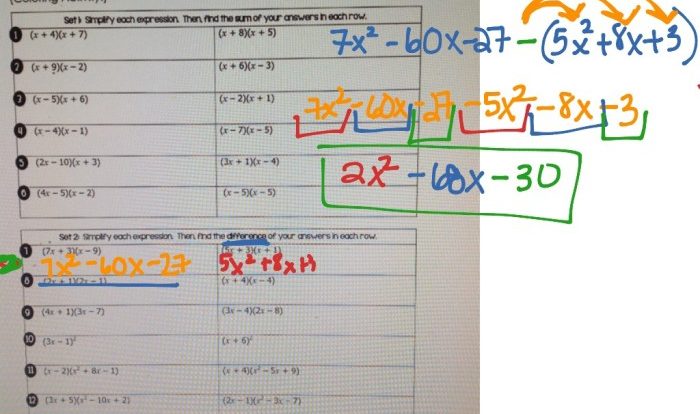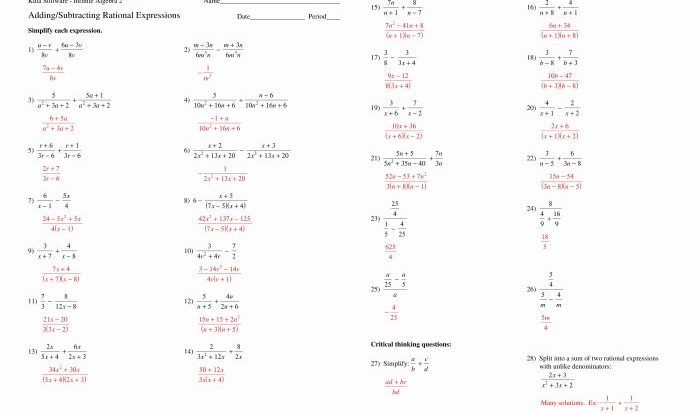Embark on a mathematical journey with Lesson 8 Homework Practice Quadratic Functions Answer Key, a comprehensive guide designed to bolster your understanding of quadratic functions. This answer key not only provides solutions to homework problems but also serves as an invaluable resource for concept reinforcement, empowering you to master the intricacies of quadratic equations and their applications.
Through a systematic exploration of quadratic functions, including their standard and vertex forms, coefficients, and solving methods, this answer key lays the foundation for a deeper comprehension of this essential mathematical concept. Step-by-step examples and insightful explanations guide you through the process of solving quadratic equations using factoring, completing the square, and the quadratic formula, highlighting the advantages and disadvantages of each method.
Lesson 8 Homework Practice Quadratic Functions Answer Key
The Lesson 8 Homework Practice Quadratic Functions Answer Key provides students with the correct solutions to the practice problems assigned in Lesson 8. This answer key is essential for students to check their understanding of the concepts covered in the lesson and to identify areas where they need further practice.
Quadratic functions are an important part of algebra, and practicing them is crucial for concept reinforcement. Lesson 8 covers various aspects of quadratic functions, including their standard and vertex forms, solving quadratic equations, graphing quadratic functions, and their applications in real-world scenarios.
Quadratic Functions Concepts and Examples: Lesson 8 Homework Practice Quadratic Functions Answer Key
Quadratic functions are polynomial functions of degree 2, typically represented in the form ax 2+ bx + c, where a, b, and c are constants. The standard form of a quadratic function is y = ax 2+ bx + c, while the vertex form is y = a(x – h) 2+ k, where (h, k) represents the vertex of the parabola.
Examples of quadratic functions include:
- y = x 2+ 2x + 1 (standard form)
- y = (x – 3) 2– 4 (vertex form)
The coefficients a, b, and c play significant roles in determining the characteristics of a quadratic function. The coefficient a affects the overall shape of the parabola, while b and c determine the vertex and y-intercept, respectively.
Solving Quadratic Equations
There are several methods for solving quadratic equations, including:
- Factoring:This method involves factoring the quadratic expression into two linear factors and setting each factor equal to zero.
- Completing the Square:This method involves adding and subtracting a constant to the quadratic expression to create a perfect square trinomial, which can then be solved by taking the square root.
- Quadratic Formula:This formula, x = (-b ± √(b 2– 4ac)) / 2a, can be used to solve any quadratic equation.
Each method has its advantages and disadvantages, and the choice of method depends on the specific equation being solved.
Graphing Quadratic Functions
To graph a quadratic function, the following steps can be followed:
- Find the vertex using the formula x = -b / 2a.
- Determine the axis of symmetry, which is a vertical line passing through the vertex.
- Find the y-intercept by substituting x = 0 into the equation.
- Plot these points and connect them with a smooth curve to create the parabola.
The coefficients of the quadratic function affect the shape of the graph. For example, a positive value of a results in a parabola that opens upward, while a negative value of a results in a parabola that opens downward.
Applications of Quadratic Functions
Quadratic functions have numerous applications in real-world scenarios, including:
- Parabolic Trajectories:Quadratic functions can be used to model the parabolic trajectories of projectiles, such as a thrown ball or a fired bullet.
- Projectile Motion:Quadratic functions can be used to calculate the height and distance traveled by a projectile.
- Optimization Problems:Quadratic functions can be used to find the maximum or minimum values of a given function, which is useful in various optimization problems, such as maximizing profits or minimizing costs.
Understanding quadratic functions is essential for solving real-world problems and making informed decisions in various fields.
Commonly Asked Questions
What is the purpose of Lesson 8 Homework Practice Quadratic Functions Answer Key?
Lesson 8 Homework Practice Quadratic Functions Answer Key provides solutions to homework problems and serves as a comprehensive resource for reinforcing concepts related to quadratic functions, solving equations, graphing, and applications.
What methods are covered for solving quadratic equations?
Lesson 8 Homework Practice Quadratic Functions Answer Key covers three primary methods for solving quadratic equations: factoring, completing the square, and using the quadratic formula.
How can I use quadratic functions in real-world applications?
Quadratic functions have numerous applications in real-world scenarios, such as modeling parabolic trajectories, projectile motion, and optimization problems. Understanding quadratic functions provides a valuable tool for analyzing and solving problems in various fields.


